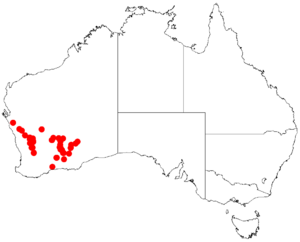Acacia duriuscula facts for kids
Quick facts for kids Acacia duriuscula |
|
|---|---|
| Scientific classification | |
| Genus: |
Acacia
|
| Species: |
duriuscula
|
 |
|
| Occurrence data from AVH | |
Acacia duriuscula is a type of shrub or small tree. It belongs to the Acacia family, also known as wattles. This plant is special because it only grows naturally in a specific part of southwestern Australia. This means it is an endemic species.
About the Plant
Acacia duriuscula is usually a straight, upright shrub or small tree. It can grow to be about 0.7 to 3 metres (2 to 10 ft) tall. Its small branches are smooth, meaning they have no hairs.
Leaves and Flowers
Like many Acacia species, this plant does not have true leaves. Instead, it has what are called phyllodes. These are flattened leaf stems that look and act like leaves.
The phyllodes of Acacia duriuscula are always green. They grow upwards and are long and narrow, like a line or a narrow oval. They can be straight or slightly curved. These leathery phyllodes are smooth and measure about 1.5 to 9.5 cm (0.59 to 3.74 in) long and 1 to 4 mm (0.039 to 0.157 in) wide. They have many thin lines running along them, with one line in the middle being a bit clearer.
This plant blooms with yellow flowers. You can usually see these flowers from July to October.
Where It Grows
Acacia duriuscula is found in the Wheatbelt and Goldfields-Esperance areas of Western Australia. It often grows near granite rocks and on flat plains. It prefers sandy or sandy-loamy soils that come from granite.
Distribution and Environment
You can find this plant scattered across a wide area. It grows from places like Mullewa and Paynes Find in the north. In the south, it can be found around Tammin, Cardunia Rocks, and Bromus.
It is part of scrubland communities. These are areas where the main plants are often different types of Eucalyptus, Acacia, or Allocasuarina acutivalvis.

